Solutions
Optimizing Rehabilitation Patient Scheduling
EXECUTIVE SUMMARY
This paper focuses on the use of process-simulation for optimizing rehabilitation patient scheduling. A proof of concept scheduling model for a major healthcare system provider in the Southeastern US, Eastern Health Systems, Inc. is constructed using a simulation tool and process characteristics like patient throughput, staff productivity, labor costs, etc. are compared to assess the effectiveness of centralized versus decentralized rehabilitation patient scheduling.
PURPOSE
The purpose of this proof of concept paper is to report results generated by rehabilitation patient scheduling alternatives. Workflow aspects like staff productivity, patient throughout, labor costs, etc. are compared to assess the effectiveness of multiple solutions.The model developed using the SIMPROCESS® simulation tool was based on data made available by healthcare experts. The model was built using an iterative approach and validated with the subject-matter-experts. Credibility of the simulation was established by comparing model results to the empirical (actual) set of data. A centralized scheduling alternative was further developed that is also discussed in this paper.
GOALS AND OBJECTIVES
The primary goal of this proof of concept effort is to use process-simulation as a mechanism for experimenting with improvement ideas in the healthcare area. A centralized scheduling scenario is developed in this context and discussed in this paper. A second goal of this proof of concept initiative was to show that an engineered approach could potentially provide additional value to subsequent, traditional project management processes.
- Examples of those processes include:
- Alternative options analysis for implementation strategies, including business process changes
- Identification of change management and training needs to support any changed business processes
- Product evaluation and selection for multiple vendor solutions
- Business Process Reengineering (BPR)
- Event-Simulation
- Queuing Theory
METHODOLOGY/APPROACH
In our approach to redesigning the rehabilitation outpatient workflow we used a repeatable process that is part of our BPR methodology. This is a formalized process that will help Eastern Health Systems, Inc. modernize and improve their processes/supporting information technology requirements. The SIMPROCESS® business process simulation product was used to speed up the data gathering, simulate "What-If" scenarios, and provide key metrics for decisions on "To-Be" process planning. Figure 1 below provides an overview of the BPR methodology.
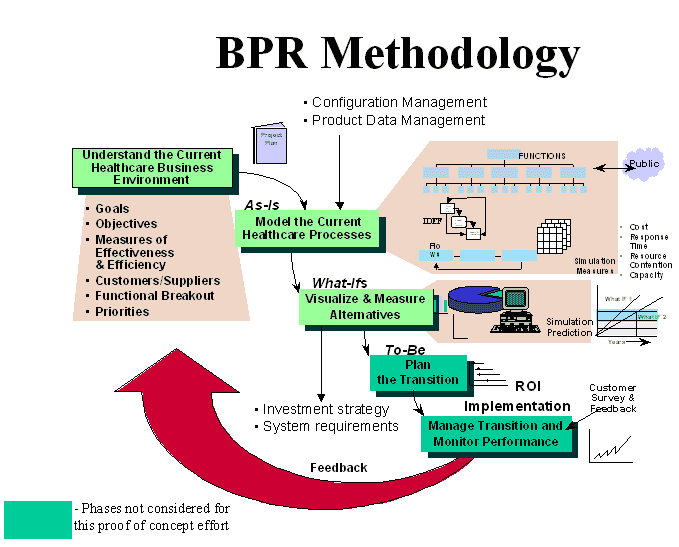
Figure 1 - BPR Methodology
This approach is based on five phases that are executed iteratively through each business area to provide an incremental approach to BPR. The incremental approach has proven to be more risk-adverse than "big-bang" top-down approach to reengineering. The five phases defined are:
Understand the Current Healthcare Business Environment
This phase focuses on setting expectations, identifying scope of the project, defining goals of the BPR effort, and defining the problems to be focused on during the BPR analysis. The BPR was performed in increments to produce benefits rapidly and to reduce risk by breaking the process into more manageable pieces.Model the Current Healthcare Processes ("As-Is")
This phase focuses on the analysis of the existing legacy healthcare processes and in developing the "As-Is" models. The legacy processes, organizational structure, and roles of the organizations were documented, measured, and baselined for comparison to the "What-If" models (centralized rehabilitation patient scheduling).Metrics required to support development of the "As-Is" rehabilitation patient scheduling model were collected through a series of interviews and workshop sessions with healthcare experts.
Items that were captured using the SIMPROCESS® simulation tool include:
- Process flow
- Frequency of actions
- Level of effort for each action
- Resources performing each action
- Source of information for each action
- Cost information
The first-cut "As-Is" rehabilitation patient scheduling model was validated and verified by the process owners of Eastern Health Systems, Inc. Validation involved review and consensus that the process flow, resources and level of effort were acceptable.Once the process flow was validated then the results of the simulation (quantities, task times, and staff productivity) were verified with the knowledge experts of Eastern Health Systems, Inc.The results of the "As-Is" rehabilitation patient scheduling model provided a quantitative baseline against which alternatives were evaluated.
Visualize and Measure Alternatives ("What-Ifs")
This phase focuses on the analysis of potential BPR improvements that were considered for implementation. Improvements typically include organizational changes, resource assignments, roles and responsibilities, process flow changes, insertion of technologies, improved access to information, and changes to policies/procedures. The "What-If" rehabilitation patient scheduling model was specifically developed to experiment with changes in the scheduling process. The centralized alternative model metrics were captured and compared to the baseline for potential quantitative benefits such as savings in cost and patient throughput.The most important metric produced from the simulations was Activity Based Cost (ABC). The ABC metric is a key ingredient in the development of a ROI for the "What-If" rehabilitation patient scheduling model and in justifying the development of the "To-Be" plans for implementation.
Plan the Transition ("To-Be")
This phase focuses on choosing the best value scenarios from the "What-If" modeling and developing implementation plans for them. The metrics from the "What-If" model will provide the basis for the choices and will assist Eastern Health Systems, Inc. in deciding which alternative should be implemented to get the most ROI. Other considerations are also factored into the decision process. Such factors as degree of reorganization, cost of training, cost of process implementation, time to implement, cost of new technology insertion, etc. are examples of additional input to the decision process. For example, a "What-If" scenario that clearly provides huge ROI benefits may be too risky to be implemented first due to the organizational or cultural impact. In this example, a lesser ROI-based "To-Be" implementation may be planned as the first increment to avoid risk of cultural change and revisited later in the implementation stages.
Manage Transition and Monitor Performance
This phase focuses on the actual implementation of the improvements. The simulation model will be used to assist in the identification of development phases and for planning the transition. The SIMPROCESS® simulation tool will be used to ensure that the process is not broken as changes are fielded and implemented.
See Model Overview and Simulation Results
MODEL OVERVIEW
Top-Level Processes
Figure 2 shows the top-level view of the healthcare simulation model. The model uses labels to display the number of (1) "Total Rehabilitation Patients", (2) "Total Rehabilitation Visits", and (3) "Average Rehabilitation Visits/Patient".Icons representing entities (i.e., patients) flow through the sub-processes where delays capture the amount of work time required for resources (i.e., clerks, doctors, etc.) to perform a given task. For this proof of concept effort the processes considered "core" are (1) Rehabilitation Scheduling and (2) Rehabilitation Therapy.
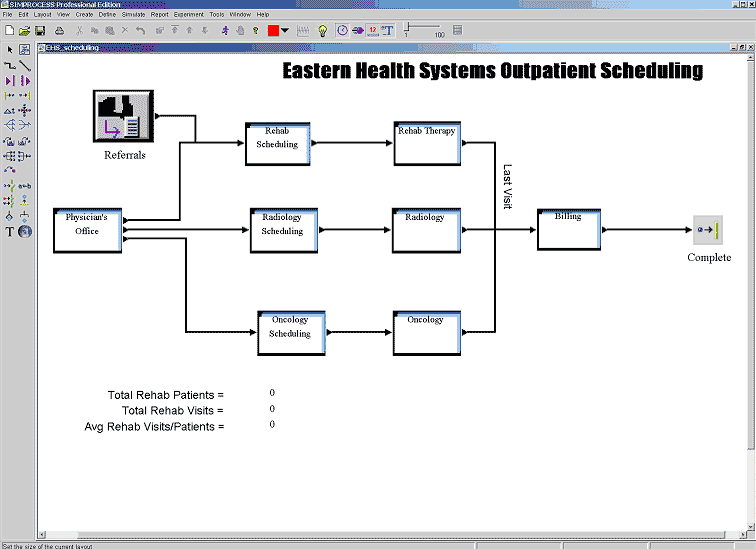
Figure 2 - Top Level Processes
"Rehabilitation Scheduling" Process Box Icon Details
The rehabilitation scheduling process box icon contains the following sub-processes: (1) Scheduling and (2) Registration. See Figure 3.
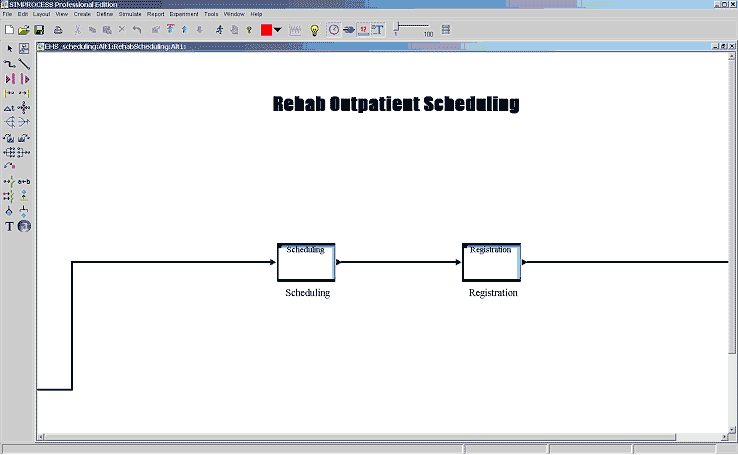
Figure 3 - Details of "Rehabilitation Scheduling" Process Box Icon
"As-Is" Rehabilitation Patient Scheduling Alternative (Decentralized)
Figure 4 below represents the details of the legacy scheduling process alternative (Scheduling Process Box Icon-Alt1).
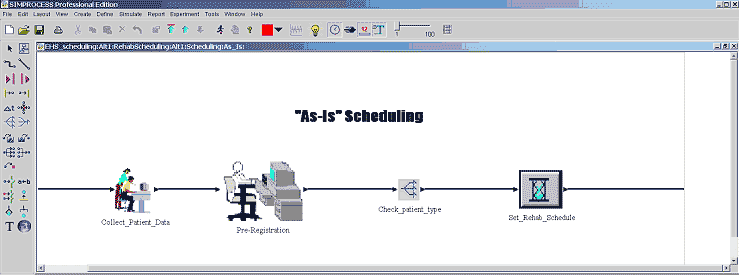
Figure 4 - "As Is" Rehabilitation Patient Scheduling Alternative
"What-If" Rehabilitation Patient Scheduling Alternative (Centralized)
Figure 5 below represents the details of the centralized scheduling process alternative (Scheduling Process Icon-Alt2). The "pre-registration" step is removed and included as part of the "collect patient data" activity.
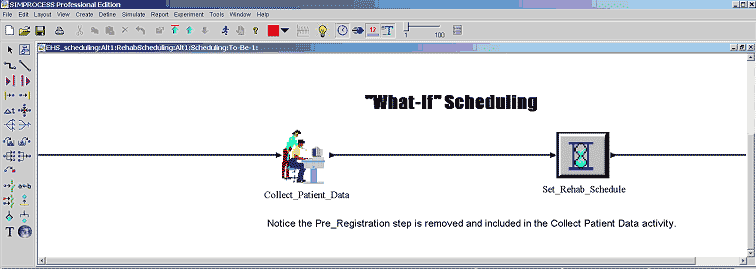
Figure 5 - "What-If" Rehabilitation Patient Scheduling Alternative
Model Settings
This proof of concept model was set to run for a ten-day period for one replication. Costs were reported at the end of the simulation run. Statistics were captured for the patient arrivals, patients in process, and patients completed.
RESULTS: Results obtained from the patient scheduling simulation model.
CONCLUSION
The healthcare simulation model provided insight into the process map and allowed for the subject-matter-experts to refine the flow based on the results of the baseline. Model metrics were collected through a set of interviews and workshop sessions and performance characteristics such as rehabilitation patient turn-around-time and labor costs were discussed with the knowledge experts periodically. An alternative was further developed to experiment with a centralized rehabilitation patient scheduling solution.
The results indicated that there were no major bottlenecks or discrepancies with the proposed solution. The composite labor cost decreased by 30% with a 60% increase in patient throughput.